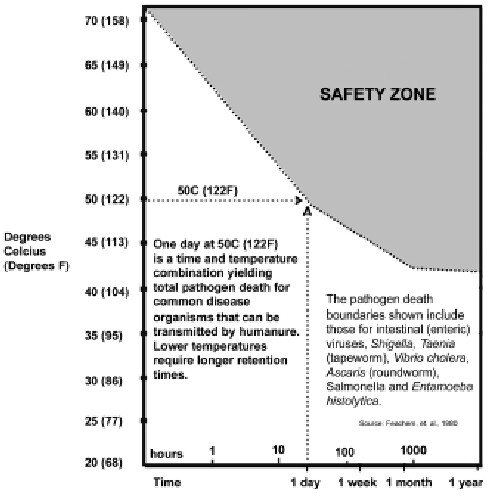
L. David Roper, http://www.roperld.com/personal/roperldavid.htm; roperld@vt.edu
06-Apr-2016
Thermophilic Composting of Human Excrement
Dehydrating/Moldering Composting of Human Excrement
A Composting Toilet for Flower Gardens
in the Hale-YMCA Community Gardens
Management of the Hale-YMCA Community Gardens
Composting Toilet
A Dehydrating Toilet for the Hale-YMCA Community Gardens
As access to fossil fuels dwindles over the next few decades, humans must learn how to live sustainably. That is, we must learn how to live using only the energy supplied by the Sun and by recycling materials. Sustainable living requires more human attention and labor than does living energized by fossil fuels. Sustainable living provides meaningful jobs instead of corporate profits.
One very important aspect of that learning curve will involve quitting defecating in our drinking water and, instead, learn again how to compost human and domestic animal excrement.
There are several advanced regions of the Earth that have already moved rapidly in recycling many aspects of human existence. This article's purpose is to summarize how these advanced civilizations accomplish recycling of human excrement by using composting toilets.
Fortunately, a forward-looking person, Joseph C. Jenkins (JCJ), has written an excellent comprehensive book about this subject, The Humanure Handbook (HH), which is available both in paperback and online. Much of the following information comes from that book.
There are two basic kinds of composting toilets:
Thermophilic composing is more energy intensive than dehydrating composting. It requires an energy source to keep the compost at a high temperature in order to completely kill human pathogens and parasites.
Any kind of composting toilet requires more human attention and labor than just pushing on a flush handle. In fact, no flush handle is involved. The basic labor for any composting toilet involves having a ready supply of non-offensive organic material to completely cover excrement every time it is deposted in the toilet. The material may be one or more of the following:
Someone must be in charge of making sure that the covering process is done continuously, in case the daily users of a composting toilet do not do it. As JCJ puts it: "... someone must take responsibility for the overall management of the toilet ... a composting toilet houses an organic mass with a high level of microscopic biodiversity. The contents are alive, and must be watched over and managed to ensure greatest success."
Thermophilic composting is the only composting method that can kill all human pathogens and parasites that can exist in human excrement. The following graph, taken from HH (p.152), shows the relationship between temperature and time required for thermophilic composting of human excrement to make the compost safe for fertilizing plants for human food:

An approximate equation for the boundary of the safety zone is T = 42 + 8/t, where T = temperature in degrees Celsius and t = time in days. For T in degrees F: T = 108 + 14/t. These equations apply only for t > 1 day.
However, as JCJ clearly shows (p.144), microorganism diversity in excrement is just as important as high temperature in killing pathogens and parasites. Too high temperature decreases biodiversity.
To enable thermophilic composting a heat source must be provided. The most sustainable way to provide the heat is by using direct energy from the Sun in an arrangement utilizing the greenhouse effect. Several designs are available for solar composting toilets:
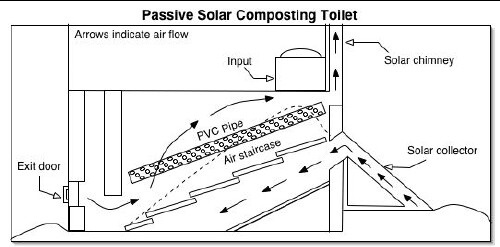
Most commercial "composting" toilets are of this type, dehydration of excrement by evaporation of the water in it. Sometimes called moldering composting, the temperature usually does not exceed 90°F (32°C). A popular commercial version is the Clivus (pronounced Cleevus) Multrum, which has two chambers placed vertically as shown below (HH p.114):
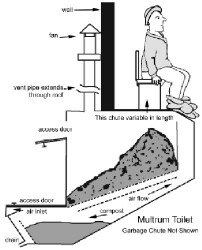
A fan powered by a solar panel dehydrates the excrement by flowing dry air around it. When material falls into the bottom chamber it is ready to be put into a standard composting system for further composting with vegetative organic matter. It should not be put directly from the toilet as fertilizer on a food garden, because the temperature never got high enough to kill all possible human parasite eggs. However, it can be used as fertilizer for flower gardens. After further thermophilic composting outside the toilet at high temperature (see first figure above), all parasite eggs will have been destroyed.
As for the thermophilic composting toilet, a carbonaceous material (e.g., sawdust, shredded paper and/or leaf mold) must cover each insertion of excrement into the toilet.
If one wants to use toilet compost for fertilizer for food plants, follow the advice of JCJ (HH p.152):
"A sound approach to pathogen destruction when composting humanure is to thermophilically compost the toilet material, then allow the compost to sit, undisturbed, for a lengthy period of time after the thermophilic heating stage has ended. The biodiversity of the compost will aid in the destruction of pathogens as the compost ages. If one wants to be particularly cautious, one may allow the compost to age for two years after the pile has been completed, instead of the one year that is normally recommended"
One does not have to be so careful if toilet compost is used for flower gardens. However, to assuage all fears of contaminated runoff into streams or percolation into ground water, I recommend that a thermophilic composting toilet (CT) for the Hale-YMCA Community Gardens be designed to follow the advice of JCJ for food gardens. The proposed CT would have a double-bottomed chamber similar to the commercial Clivus-Multrum CT and the solar composting toilet of Longbranch. Direct solar energy utilizing the greenhouse effect would provide the high temperature needed for thermophilic composting, as for the Longbranch version. A solar panel would provide power for a fan to dehydrate the excrement and remove any remaining smells out a roof vent, as for the Clivus-Multrum version. A container of sawdust, shredded paper and/or leaf mold (from the Town of Blacksburg leaf collection) would be inside for covering excrement.
A soil-temperature probe attached to a data logger would moniter the temperature in the middle of the compost pile under the toilet to assure that the temperature is high enough to kill all human pathogens and parasites.
A part-time manager will have the following responsibilities:
There are two major options for dehydrating composting toilets, as discussed below.
The “Enviro Loo” solar evaporative toilet uses thermal solar energy to reduces excrement to a dehydrated solid and removes the released gases through a roof vent, all provided by solar thermal energy. Then the dry solid can be either hauled off by a septic truck to a waste-treatment plant or put in a composting facility with garden waste.
I recommended this one for the Hale-YMCA Community Gardens.
Another similar possibility is the Clivus Multrum. Instead of using thermal solar energy to dehydrate the excrement, it uses solar electricity to run a fan to move the air to dehydrate.
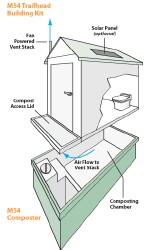
Neither of them require depositing of organic material, such as sawdust, when defecating, although the Clivus Multrum recommend such use once a month. They just dehydrate the excrement with moving air powered by the Sun.
A major question is their relative costs: The Clivus-Multrum Trailhead M54 Trailhead complete with building is $24,000. The Enviro Loo SWS-2020 toilet system is $2960, not including tax and shipping; they have an ADA-compliant 6'x8' building (metal studs injected with Styrofoam with reinforced fiberglass panels inside and Hardie panels outside) for $7416, not including tax and shipping.
The Blacksburg Parks and Recreation department has installed a 10'x10' Enviro Loo SWS-2040 commercial version at the Kipps Elementary School recreational area:
 |
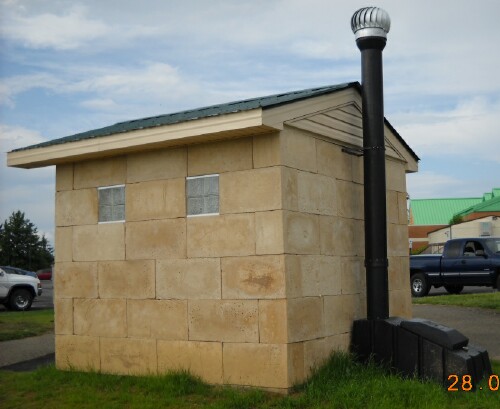 |
A part-time manager will have the following responsibilities: